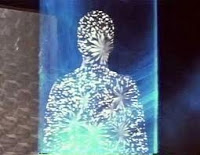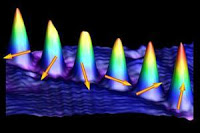
Ever want to have a "life do over", teleport, time travel, have your computer work at lightening speed or be guaranteed of no turbulence on your next flight, while many of these things are on the horizon. Make no mistake about it, quantum physics has been around for sometime but it is just about to change all of our lives.
Quantum physics deals with the behavior of the smallest things in our universe: subatomic particles. It is a new science, only coming into its own in the early part of the 20th century, when physicists began questioning why they couldn't explain certain radiation effects. One of those pioneering thinkers, Max Planck, used the term "quanta" for the tiny particles of energy he was studying, hence the term "quantum physics". Planck said the amount of energy contained in an electron is not arbitrary, but is a multiple of a standard "quantum" of energy. One of the first practical uses of this knowledge led to the invention of the transistor.
1. Parallel Universes
 Ever
wonder what life would be like if you could travel back in time?
Would you assassinate Hitler? Join the Roman legions and see the
ancient world? Ask the head cheerleader to the prom? While we've all
got fantasies of what we'd do if given the opportunity, scientists
at the University of California Santa Barbara may have cleared the
path to righting the wrongs of years gone by.
Ever
wonder what life would be like if you could travel back in time?
Would you assassinate Hitler? Join the Roman legions and see the
ancient world? Ask the head cheerleader to the prom? While we've all
got fantasies of what we'd do if given the opportunity, scientists
at the University of California Santa Barbara may have cleared the
path to righting the wrongs of years gone by.In a 2010 experiment, the scientists proved that an object may exist simultaneously in two different worlds. They isolated a tiny piece of metal, struck it like a tuning fork and observed that it moved and stood still at the same time. While you probably would have just racked this observation up to delirium caused by overwork, these physicists say it proves that observing an object and action splits the universe into two parts -- one we can see and one we can't. The parallel universe theory says everything freezes during observation -- and then splits.
Scientists are trying to figure out how to jump at the moment of that split from the world we will enter into the one we won't. This parallel universe time travel theory should work, scientists say, because quantum particles move backward and forward through time . Now, all scientists have to do is build a time-bending machine using these quantum particles.
2. Quantum Computing
 Another
world-changing aspect of quantum physics may come in the
computing realm, where a type of superconducting circuit is
giving computers unprecedented speed and power. The circuits
behave like artificial atoms, researchers say, because they can
only gain or lose energy in packets by moving between discrete
energy levels. The most complicated atom has five energy levels.
This type of system is known as a "qudit" and is a vast
improvement over the previous "qubit," which had only two energy
levels. Qubits and qudits take the place of the bits used in
standard computers. These quantum computers will use the laws of
quantum mechanics to perform computations much faster than
traditional computers.
Another
world-changing aspect of quantum physics may come in the
computing realm, where a type of superconducting circuit is
giving computers unprecedented speed and power. The circuits
behave like artificial atoms, researchers say, because they can
only gain or lose energy in packets by moving between discrete
energy levels. The most complicated atom has five energy levels.
This type of system is known as a "qudit" and is a vast
improvement over the previous "qubit," which had only two energy
levels. Qubits and qudits take the place of the bits used in
standard computers. These quantum computers will use the laws of
quantum mechanics to perform computations much faster than
traditional computers.3. Quantum cryptography
All
sorts of information, from your credit card numbers to
top-secret military strategies, are on the Internet, and a
skilled hacker with enough knowledge and computer power
could play havoc with your finances or world
security.Encryption codes keep that information secure, and
computer experts work ceaselessly to come up with more and
more secure methods.
Encoding messages inside an individual particle of light, or photon, has long been the goal of quantum cryptographers. That method seems to be just at hand, as scientists at the University of Toronto have worked with a method fast enough to encode a video . Cryptography involves a string of ones and zeros called the "key." Adding the key once encodes the information, adding it again decodes it. If an unauthorized person manages to obtain the key, the code can be cracked. But in quantum key distribution, the very act of using the key would reveal the hacker's presence.

Haven't we all imagined what it would be like to
instruct Scotty to beam us up, then dissolve into a
stream of particles, only to be reassembled in another
place? It's science fiction no more; it has been done,
not on humans but on large molecules. Therein lies the
problem. Every molecule in the human body would have to
be scanned and then reassembled on the other side. But
that's not going to happen any time soon. Another thing:
Once you scan the particle, according to the laws of
quantum physics, you have changed it. You can't make an
exact copy.

Scientists are using something very, very big -- the Large
Hadron Collider -- to look for something very, very small:
the fundamental particle believed to be at the root of our
universe. The Higgs boson -- sometimes prosaically called
the "God particle" -- is what scientists believe gives mass
to fundamental particles (electrons, quarks and gluons) .
Scientists believe the Higgs boson field must pervade all
space, but so far the existence of these particles is just a
theory. By isolating the Higgs boson, physicists might be
able to understand how the universe went from a dense mass
at the moment of the Big Bang to the infinitely spacious
universe we have today. It might also explain how matter
came to be balanced with antimatter. In short, finding the
Higgs boson might explain everything.

It
is hard to imagine that the Native American, shamanistic
healers and the pioneers of quantum physics would have
much in common, but it turns out they do. Niels Bohr,
one of the early investigators into this strange field
of science, believed that much of what we call reality
was dependent on an "observer effect," the relationship
between what our reality does and how we observe it.
This became a huge debate among quantum physicists, but
experiments more than half a century after Bohr proposed
his theory provided some support for it.
According to some physicists who have tested Bell's inequality, reality is based on the observer effect, which could explain the power of shamanistic healing and the interaction between the reality of local space-time and human consciousness. As far back as 1998, controlled experiments have demonstrated the effect of observation on particles .
One day
soon, quantum physics may
help doctors locate cancer cells in the body and pinpoint
exactly where the cells have spread. Scientists have
discovered that some tiny semiconductor crystals called
quantum dots glow when exposed to ultraviolet radiation and
photographed with a special microscope . They
then coat the quantum dots with a material that is
attractive to cancer cells. When injected into the body, the
coated glowing quantum dots latch on to cancer cells,
showing doctors exactly where to look for the cells. The
glow coating is long-lasting, and it is relatively easy for
scientists to customize it to fit the specifications of the
particular type of cancer they are searching for.
While high-tech science certainly is responsible for many medical breakthroughs, man was dependent on other means of fighting illness for centuries.

A
new magnetic semicconductor developed
at the Massachusetts Institute of Technology may lead to
faster yet more energy-efficient electronic devices in
the future. Called "spintronics," this technology uses
the spin state of electrons to transmit and store
information. While conventional electronic circuits use
only the charge state of an electron, spintronics takes
advantage of the electron's spin direction.
Processing information through circuits with spintronics would allow information to be carried in two directions at once, further reducing the size of electronic circuits . This new material injects electrons into the semiconductor based on their spin orientation. The electrons travel through the semiconductor and are ready to be a spin detector on the other side. Scientists say the new semiconductor can work at room temperature and is optically transparent, meaning it could work with touch screens and solar cells. They are also optimistic that it will enable inventors to come up with even more multi-functional devices.
Soon,
quantum physics may
have eliminated that bumpy ride that causes you to spill
your drink on an airplane. By creating quantum turbulence in
an ultra-cold atom gas in the laboratory, Brazilian
scientists may have come across a method of studying the
turbulence that interferes with airplanes and boats. For
centuries, turbulence has stumped scientists because of the
difficulty in re-creating the conditions that cause it to
form.
Turbulence is caused by swirls in a gas or liquid, and in nature occurs in a chaotic manner, seemingly without rhyme or reason . While turbulence can form in air and in water, physicists have discovered it can also form in ultra-cold atom gases and superfluid helium. By studying turbulence in a controlled method in the lab, scientists may one day be able to predict and perhaps control it in nature.

Something called entanglement may
be a major influence on the future of solar power.
Entanglement means the quantum interconnection of
objects, such as atoms that are separated in actual
physical space. Physicists believe that entanglement may
occur in the parts of plants responsible for
photosynthesis, or the conversion of light into energy.
The structures responsible for photosynthesis, the
chromophores, can turn 95 percent of the light they take
in into energy . Scientists are examining
how this interconnection on the quantum level can
influence solar energy creation, in hopes of developing
efficient solar cells based on nature. Scholars have
also discovered that algae may be using some form of
quantum mechanics to move energy derived from light and
may actually be able to store the energy in two places
at once.
A few famous minds on Quantum Physics.
[I can't accept quantum mechanics because] "I like to think the moon is there even if I am not looking at it."Albert Einstein
But Heisenberg went on to insist that these philosophical issues raised by quantum mechanics applied to the big as well as the small."[T]he atoms or elementary particles themselves are not real; they form a world of potentialities or possibilities rather than one of things or facts."
Werner Heisenberg




